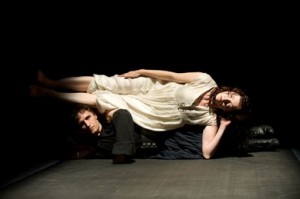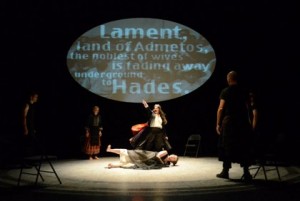
Pete Simpson and Tymberly Canale in Big Dance Theater's 'Supernatural Wife' (photo Christopher Duggan)
JACOB’S PILLOW
Big Dance Theater
Thursday, July 28, 2011
Review by Anna Rogovoy
(BECKET, Mass.) – An hour-long work which lies somewhere in a liminal space between dance and theater, Supernatural Wife – enjoying its U.S. premiere in the Doris Duke Theater at Jacob’s Pillow through Sunday, July 31 — is delicately wrought and luminous. Co-Artistic Directors of Big Dance Theater, Annie-B Parson and Paul Lazar created this work in collaboration with the cast as a retelling of Euripides’ Alkestis featuring movement, dramatic text, song, scenic design, and digital projections.
In the beginning, the performers sit facing each other around the edge of a white circle on the floor. Two men rise and begin to jog in place, executing a series of complex hand gestures that seem as though they could be a hybridization of American Sign Language, everyday movements, and classical ballet port de bras. They are joined, one by one, by four others, until they all jog and gesture together. The vocabulary expands into folk dance-esque hops and skips with arms raised, but their expressions are far from celebratory: this is, after all, a tragedy. Or is it?
The story of Alkestis can be summarized as follows: King Admetus (portrayed here by Molly Hickok) evades death by allowing another to die in his place, but that other winds up being his beloved wife, Alkestis (Tymberly Canale). Luckily for both of them, Herakles (Pete Simpson) stops by Ademetus’ home and, upon learning of Alkestis’ demise, travels to the Underworld to bring her back. The couple is reunited. “That’s how this went,” quips Chris Giarmo, whose role in the production seems something akin to Sarcastic Stage Manager; he sits off to the side of the action interjecting stage directions and notes through a microphone, periodically joining in the dancing.
Each performer does his or her fair share of talking, singing, and dancing, and each has a part to which he or she seems uniquely suited. Elizabeth DeMent, a performer endowed with steely control and grace, represents a servant in Admetus and Alkestis’ household, aiding and often echoing her masters in both movement and speech. Entrusted with the most technically challenging choreography is Aaron Mattocks, who portrays Death with cold, unrelenting power. Mattocks moves sinuously, eerily, embodying a specter who can drop to the ground effortlessly at any moment and is always poised and waiting.
Other characters — Alkestis and Admetus’ children, Admetus’ father — are represented via recordings played on TV monitors. Video projected onto the back wall of the stage features images of weeping women, lyrics to a song being sung by the performers, a flickering candle. Props include a pair of red velvet curtains, a pair of bricks, a full drum kit, and an ornate chandelier “shot” irreverently from the ceiling by Herakles. Costume changes indicate changes of character and also changes of condition within a character: when Canale slips into a gauzy black over-dress, we understand that Alkestis has passed into the Underworld.
The ending is particularly strong. Hickok, whose depiction of Admetus is unpredictable yet touching, reaches a new level of emotional tenderness as she touches Canale’s arm, visibly shuddering at the thought of touching a woman she thinks is not her wife, and the moment in which she realizes that it is Alkestis is heart-wrenching.
But it is Canale’s final solo as Alkestis returns from the Underworld that is absolutely gripping. Simpson (as Herakles) has said that she will not be able to speak for several days until she has completely shed the traces of death, and this dance looks to be an effort to do so. It’s in the same vocabulary of narrative-infused gesture and low jumps and skips as the rest of the piece, but Canale imbues the movement with a new depth that speaks to a journey to and from a place beyond where living humans may visit. And Giarmo’s final words speak to a straightforward sense of humor and wisdom that can only come from artists as adventurous, well-rounded, and prepared to laugh in the face of tragedy as Annie-B Parson and Paul Lazar.
Anna Rogovoy is The Rogovoy Report’s chief dance critic. She studies dance, literature and writing at Bennington College.

